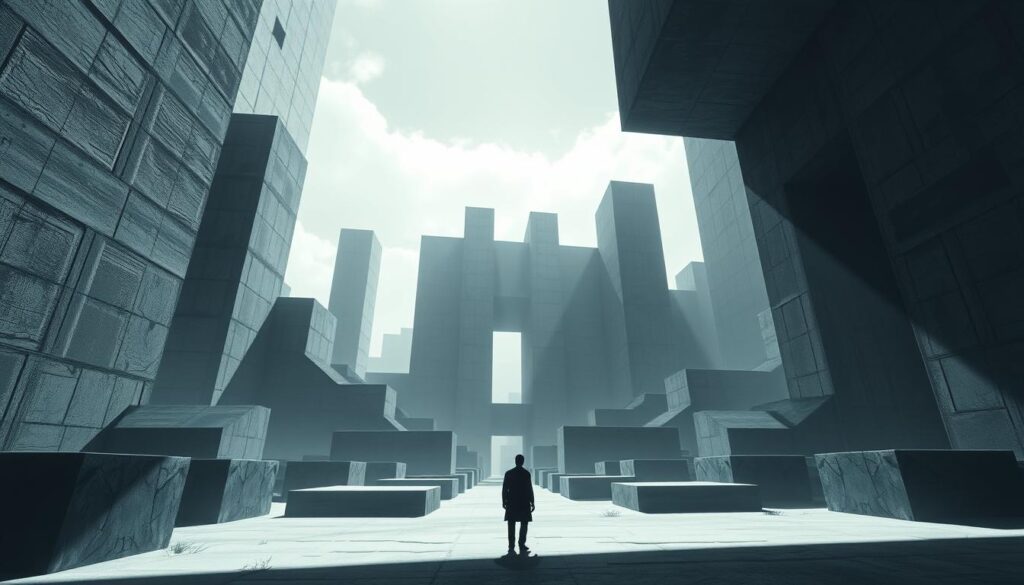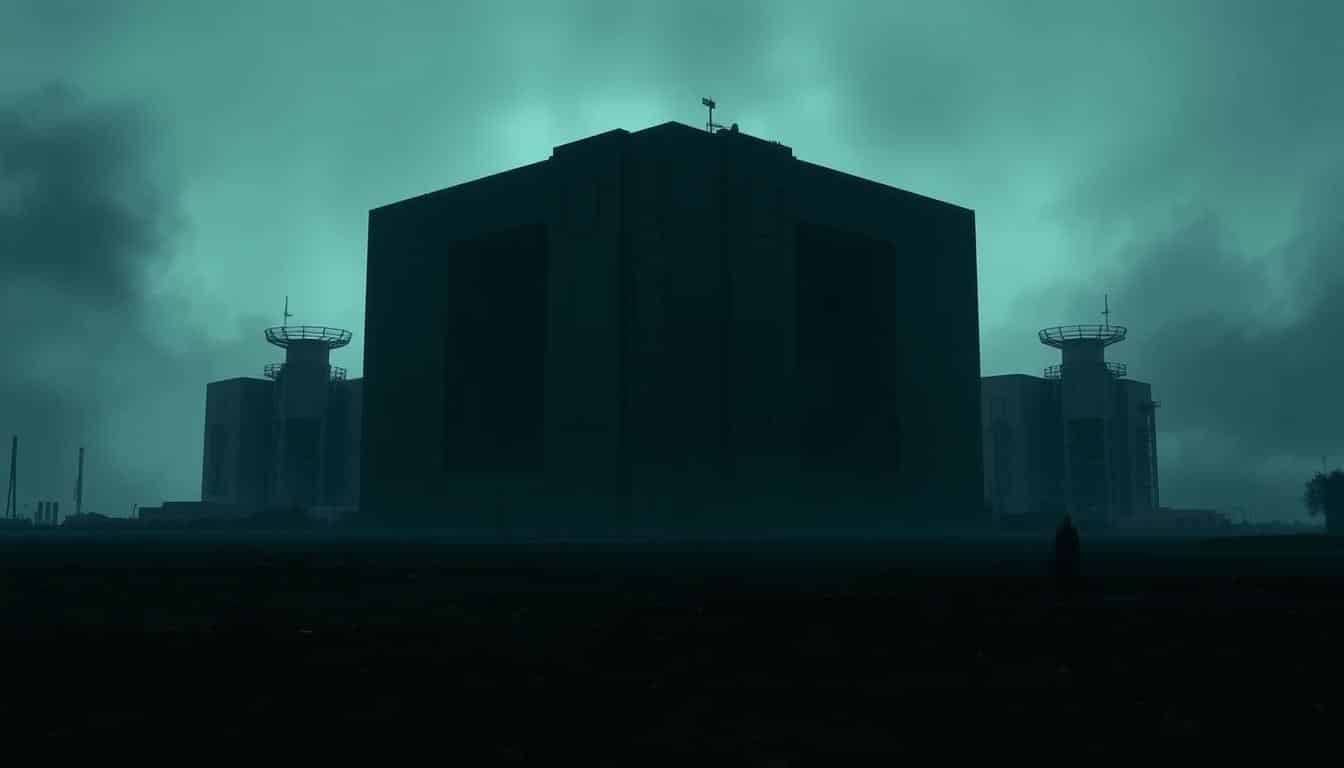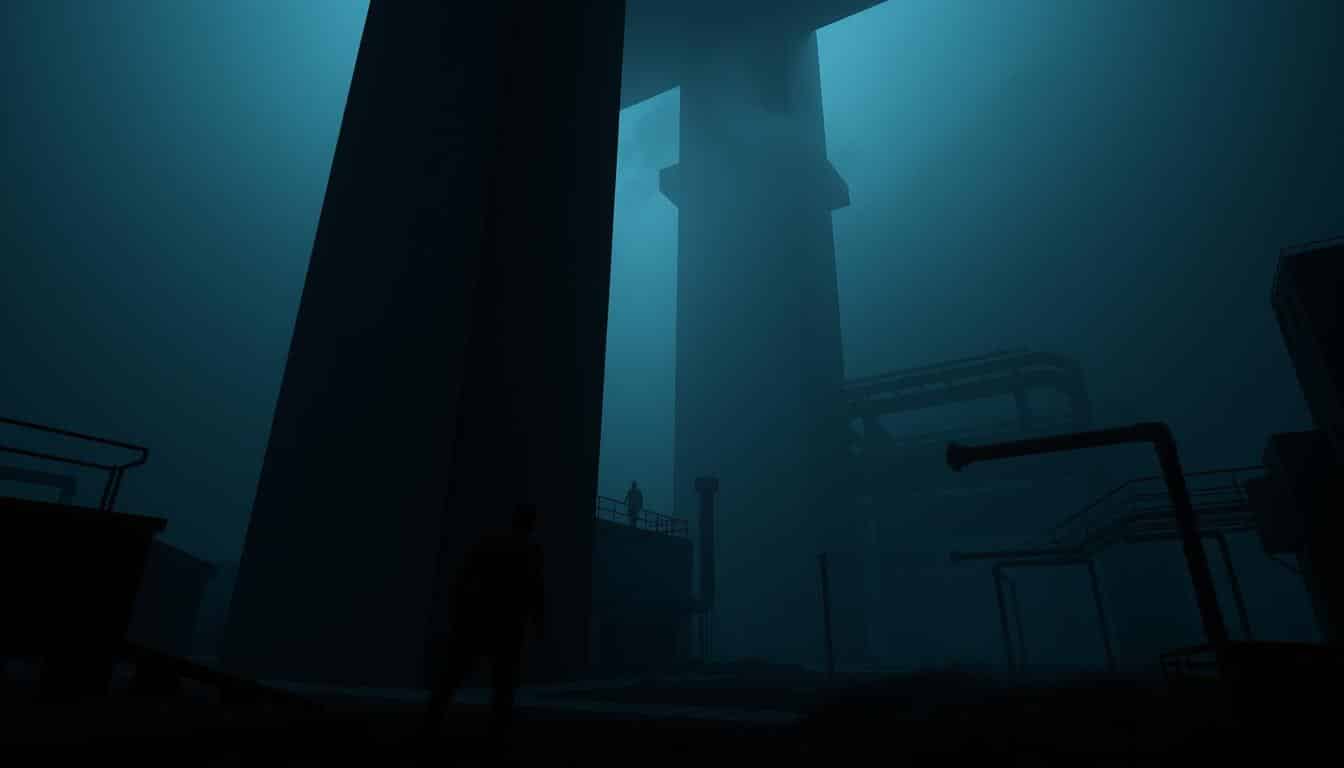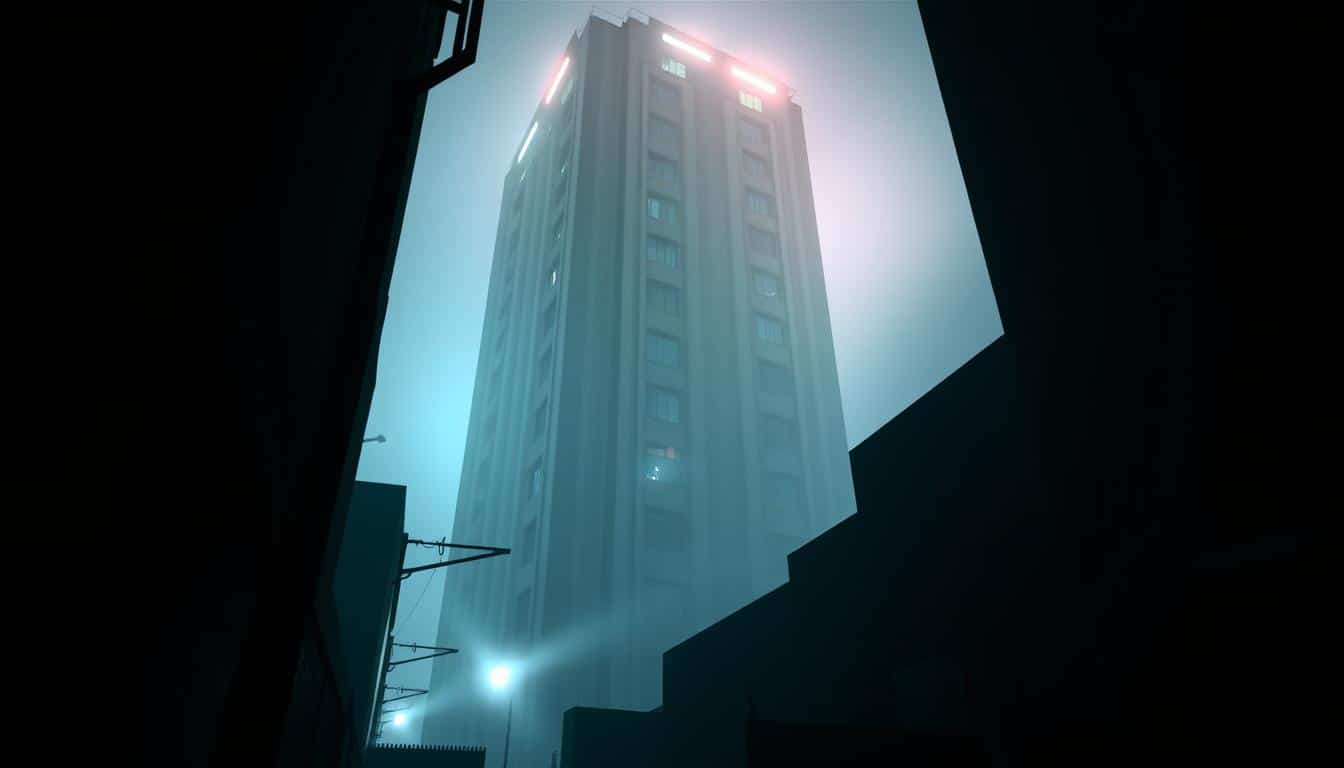Recently, the mix of brutalist architecture and horror games has attracted a lot of attention. This architectural style is known for its simple, raw look. It creates a strong setting that makes horror games more intense and emotional.
Looking into horror games, we find symbols that show how architecture affects how players feel. This adds to the scary and suspenseful atmosphere. We’ll see how the bold style of brutalism makes horror games unforgettable, drawing players into a deeply impactful experience.
The Rise of Brutalist Architecture in Gaming
Brutalism goes beyond just city buildings. When we look at brutalism’s history, we see its big role in video games. This style started in the mid-1900s. It’s known for its simple concrete look and valuing function over beauty. It shows the culture of its era, with buildings that are honest about their materials and how they’re built.
Historical Context of Brutalism
Brutalism has evolved a lot over the years. It began after the war, aiming to meet people’s needs with practical buildings. Places like the Barbican Centre in London and Boston City Hall show its unique look. They have plain surfaces that ditch fancy details, showing truth to viewers.
Influence on Game Design
Lately, brutalism in games has caught people’s eyes with its unique look. Developers use this style to make worlds that pull you in. The big, bold structures of brutalism give a feeling of being alone and curious. This makes games more gripping.
These games take us to places that look like real brutalist buildings. This makes the games more intense. Plus, using brutalism helps make new kinds of game plays, breaking old rules and starting new trends in design.

The Aesthetic of Brutalism in Horror Games
Horror games with brutalism use a special visual style to draw players in. This style includes simple forms, bare concrete, and mostly gray colors. These elements make the game’s world feel cold and scary.
They make it easier for players to get sucked into a spooky, minimalistic setting. This setting makes horror games even more intense and nerve-wracking.
Visual Language and Design Elements
Brutalism’s key features like sharp angles and big buildings are important for telling the story. They make the game’s world feel large and unknown, which ups the tension. Using concrete and metal, game makers create a world that feels real and raw.
This makes the game more engrossing. Players find themselves more involved in the story, leading to scarier moments.
Contrast with Traditional Horror Settings
Brutalism stands out when you compare it to classic horror settings. Traditional settings might remind you of old, haunted houses or creepy churches. But brutalism’s bold lines and big structures push players to face fears in new ways.
This change from fancy to plain spots brings new thoughts about feeling alone and scared. It adds variety to horror games.
Uncovering the Symbolism of Brutalist Structures in Horror Games
Architecture greatly influences how we feel in games, especially horror ones. The design of buildings in games can deeply affect our emotions. Brutalist structures, known for their stark and raw looks, often make us feel anxious or unsettled during gameplay.
Psychological Impact on Players
Brutalist architecture is stark and severe, sparking strong emotions. People playing games with such designs might feel uncomfortable or even scared. This unease is due to how brutalist buildings make us feel more anxious.
Studies show that architecture in games shapes our experience. This is really important in horror games. The grim feeling of brutalism makes players tackle their fears.
Interpretations of Isolation and Despair
In horror games, brutalist architecture stands for bleakness and feeling alone. These themes hit hard in these games. The sense of being isolated gets stronger with the daunting spaces brutalist structures have.
Game makers use this to deepen the despair in their stories. These kinds of places often show up in stories that make players feel hopeless. This helps players feel more connected to the story and its emotions.
Case Study: 0_abyssalsomewhere
The game 0_abyssalsomewhere shows how architecture can shape a game’s mood. It’s not just about looks. The design deeply affects how players feel during the game. They move through bleak concrete spaces. This brings out feelings of loneliness and fear, making the fear feel more real.
Atmospheric Horror and Brutalist Influences
The game 0_abyssalsomewhere wraps you in a scary mood, a lot of it comes from its use of brutalist architecture. This style makes the scary parts more intense. It shapes how you experience the game. You’ll find:
- Naked, simple structures that make you feel uneasy.
- An experience that makes horror feel almost real.
- Designs that remind you of being alone and scared.
By using these brutalist details, the game drops players into a world that’s deeply unsettling.
The Role of Architecture in Gameplay Experience
In 0_abyssalsomewhere, the architecture is a big deal. It doesn’t just guide where you go. It also plays with your feelings and decisions. As you play, you might feel:
- More worried as you wind through confusing paths.
- Exposed and at risk due to the layout.
- Forced to think hard about how to stay alive.
This thoughtful interaction with space makes the gaming experience richer. It dives deep into horror as you play.
Dark Narratives and Brutalist Backdrops
In horror games, dark stories and brutalist architecture work together to make an experience that deeply moves players. The design of these buildings often shows the game’s main conflicts. This makes players feel the themes of pain, conflict, and survival, connecting them more to the story.
Architecture as a Reflection of Themes
Brutalism is more than just a style in games; it tells a story. Its rough, raw look matches the dark stories in horror games perfectly. The buildings show parts of the story, emphasizing key points and emotions. This makes players think more deeply about the game’s themes.
As they explore, the setting doesn’t just change their experience. It also shows the deep challenges the characters face. This pushes players to think more about the story.
Environmental Storytelling in Horror Games
Game creators use the environment to tell complex stories without saying a word. They use brutalist designs to set a scene of loneliness and fear. These places tell their own stories, encouraging players to understand the world’s past and challenges.
This mix of storytelling and architecture makes for a powerful experience. It captures players’ attention and pulls them into the story.
The Contradictions of Brutalism in Gameplay
Horror games with brutalism bring a mix of appeal and unease. This mix sits at the core of beauty and roughness in buildings. It makes players think deeply as they explore eerie places. The clear lines and big structures bring a visual clash that stirs strong feelings.
Beauty vs. Brutality
Players are pulled in by the unique look of brutalist design. They enter complex places filled with artistic charm. Yet, this charm comes with tough, bleak parts that make them feel trapped and scared. These contrasts in game design make the experience richer. They push the story and let players dig into themes like being alone and fear.
Player Emotion and Engagement
Brutalism makes players feel more by putting them in a world that’s both fascinating and scary. This mix makes players more involved through its design. They have to face their emotions in these hard, unforgiving places. By bringing out a wide range of feelings, creators make games more than just play. They turn them into deep dives into fear and mystery.
Architectural Symbolism in Iconic Horror Titles
Brutalist architecture is key in many horror games. It shapes the mood and adds depth to the story. Its cold, simple look helps players feel more involved and touches on themes like fear and uncertainty. Games use this style to draw players into creepy settings that mirror their dark stories.
Influences from Notable Games
Many famous horror games feature brutalist architecture to create tension. For example, “Silent Hill” and “Resident Evil” show how buildings impact gameplay and the story. These heavy, confusing structures make players feel scared, connecting them closer to the game’s story through the setting. The brutalist designs are not just backdrops but key parts that shape the player’s journey.
Brutalist Structures in Game Lore and World-building
Brutalist elements in horror games make their worlds more engaging. They add realism, deepen stories, and get players more hooked. Exploring grim buildings lets players dive deep into themes of loneliness, madness, and despair. This connection between architecture and story helps players understand the game better, making the experience more impactful.
Brutalism’s Relation to Fear and Uncertainty
Brutalist architecture sets the stage for fear in horror games. Its harsh lines and big concrete forms make players feel alone and uneasy. Game designers use this style to play with your feelings, making you scared and unsure.
Tight spaces and complex corridors are especially good at making the game feel scarier.
Creating Tension Through Architectural Choices
In horror games, brutalist elements make everything more tense. Features like:
- Confined spaces that trap players in uncomfortable locations
- Twisting hallways that create a sense of disorientation
- Monolithic structures that instill feelings of insignificance
These design choices push fear to the forefront. They turn game environments into challenges. Players must face their fears in settings that are both new and oddly familiar, making the game more intense.
The Role of Spatial Awareness in Horror
Knowing where you are is key in games with brutalist settings. This knowledge affects your choices, especially during scary moments. As you walk through metal and concrete mazes, your ability to spot danger is always tested.
This awareness can lead to exciting or frightening situations. The balance between what you see and the hints you get makes horror games truly terrifying. Being aware of your environment is crucial for the scary experience.
Comparative Analysis: Brutalist vs. Other Architectural Styles
The exploration of architectural styles in horror shows an interesting change over time. Brutalism, known for its bold and often daunting look, stands out. When compared to other styles in horror games, it affects the atmosphere. This sets up what players expect and makes the game more immersive.
The Evolving Horror Aesthetic
Different architectural styles affect how players feel. Brutalism can make players feel alone and scared. Other styles might make players feel safe or remind them of the past. Comparing these styles shows how they change the mood of a horror story. For example, gothic architecture with its detailed work brings mystery and suspense. But a simpler design might feel empty and confusing.
Implications for Future Game Design
Using brutalism in game design could lead to new trends. Developers might use these styles to tell stories in new ways. The clear differences and raw look of brutalism can make games more engaging. It helps players feel more involved and heightens their emotions. Knowing about architecture in games can help create new ideas. These ideas can take the horror genre to exciting new places.
Conclusion
We have learned a lot about brutalist symbols in horror video games. These big, stark buildings can make players feel alone and scared. They also make game stories deeper and more interesting.
These buildings create a creepy atmosphere that fits perfectly with scary games. They tap into our fears, making the game experience more intense.
Looking into the future, mixing these bold designs with new tech seems promising. As video games evolve, designers can make even scarier and more involving settings. This means that knowing about architecture is key to making great horror games.
In wrapping up our talk on horror and design, brutalist buildings challenge what we expect in games. They pull us into thrilling, memorable adventures. The future of horror games looks exciting, with many chances for creativity and deep connections.



